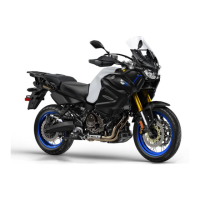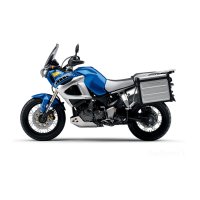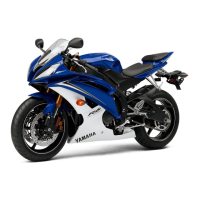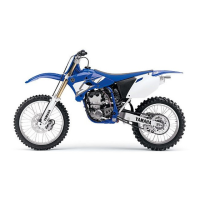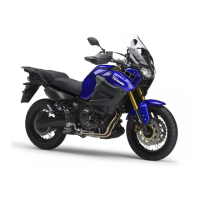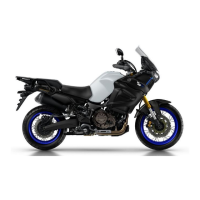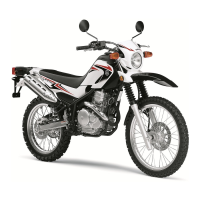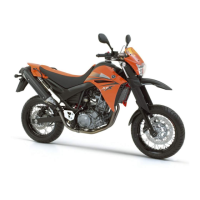Do you have a question about the Yamaha XT1200Z 2010 and is the answer not in the manual?
Details on vehicle identification number and model label location.
Overview of key systems like FI, UBS, ABS, TCS, and instrument functions.
Guidelines for preparation, parts, and general service information.
Information on quick fasteners, and electrical system handling.
List of necessary special tools with part numbers and reference pages.
Motorcycle dimensions, weight, maximum load, and model variations.
Detailed engine data including type, displacement, bore, stroke, compression, oil, and fuel specs.
Details on frame, wheels, tires, brakes, clutch, steering, and suspension.
Voltage, ignition, starter, horn, fuses, and various component specifications.
General and specific torque values for fasteners and assemblies.
Identifies lubrication points and recommended lubricants for engine and chassis components.
Visual representation of the cooling system components and flow.
Instructions and diagrams for routing electrical wires and cables on the motorcycle.
Schedule and job list for regular maintenance tasks based on odometer readings.
Chart detailing general maintenance and lubrication tasks at different intervals.
Step-by-step procedure for measuring and adjusting valve clearance on a cold engine.
Procedure for synchronizing throttle bodies using vacuum gauges and checking for proper operation.
Procedure for checking brake fluid levels in the master cylinder reservoir.
Procedures for bleeding the ABS hydraulic brake system after component removal or if faulty.
Guidelines for checking tire pressure, tread depth, wear limit, and surfaces for damage.
Procedure for checking and adjusting steering head bearing play and tightness.
Step-by-step instructions for draining and replacing engine oil and oil filter.
Procedure to check the coolant level in the radiator and reservoir.
Procedure to check the final gear oil level and add oil if necessary.
Covers removal and installation of seats, carriers, side cowlings, and electrical components.
Procedures for removing, disassembling, checking, balancing, and installing the front wheel.
Procedures for removing, disassembling, checking, and installing the rear wheel.
Covers removal, disassembly, checking, and installation of brake pads, calipers, and master cylinder.
Covers removal, disassembly, checking, and installation of brake pads, calipers, and master cylinder.
Detailed procedures for removing, installing, checking, and testing ABS components and system.
Procedures for removing, checking, and installing handlebar components like grips, levers, and switches.
Procedures for removing, disassembling, checking, and assembling front fork legs.
Procedures for removing, checking, and installing steering head components and bearings.
Procedures for handling, disposing, removing, checking, and installing the rear shock absorber.
Procedures for removing, checking, lubricating, and installing the swingarm.
Procedures for removing, disassembling, checking, and aligning final drive components and drive shaft.
Procedures for measuring compression pressure and general engine checks.
Step-by-step process for removing the engine, including exhaust pipe disconnection.
Procedures for removing, checking, and installing camshafts, sprockets, and related components.
Procedures for removing, checking, and installing the cylinder head, including valve clearance.
Procedures for removing, checking, cleaning, lapping, and installing valves, springs, and guides.
Procedures for removing, checking, and installing cylinders, pistons, and piston rings.
Procedures for removing, checking, and installing the generator, starter clutch, and torque limiter.
Procedures for removing, disassembling, checking, and assembling the starter motor.
Procedures for removing, checking, and installing clutch components, including plates and master cylinder.
Procedures for removing, installing, and checking the pickup rotor and its gap.
Procedures for removing, checking, adjusting, and installing the shift shaft and related components.
Procedures for removing, checking, assembling, and installing the oil pan, strainer, and oil pump.
Procedures for removing, disassembling, checking, assembling, and installing crankcase components.
Procedures for removing, checking, and installing crankshaft, connecting rods, and balancer shafts.
Procedures for removing, checking, assembling, and installing the transmission, shift drum, and shift forks.
Procedures for removing, disassembling, checking, and aligning middle gear components.
Procedures for removing, checking, and installing the radiator and related hoses.
Procedures for removing, checking, and installing the thermostat and its cover.
Procedures for removing, disassembling, checking, assembling, and installing the water pump.
Procedures for removing and installing the fuel tank and fuel pump.
Procedures for removing, checking, cleaning, and installing throttle bodies, injectors, and sensors.
Procedure for checking fuel injector pressure using a pressure gauge.
Procedure for checking fuel pressure using a fuel pressure adapter and gauge.
Procedure for checking and adjusting the throttle position sensor angle.
Procedure for checking and adjusting the accelerator position sensor angle.
Procedure for installing throttle body joints onto cylinders and throttle bodies.
Circuit diagram and troubleshooting for the ignition system.
Circuit diagram and troubleshooting for the electric starting system.
Circuit diagram and troubleshooting for the charging system.
Circuit diagram and troubleshooting for headlights, taillights, and other lighting components.
Circuit diagram and troubleshooting for turn signals, brake lights, horn, and hazard lights.
Circuit diagram for the cooling system.
Circuit diagram, ECU self-diagnosis, and troubleshooting for the fuel injection system.
Circuit diagram and troubleshooting for the fuel pump system.
Circuit diagram, general info, part replacement, key registration, and troubleshooting.
Circuit diagram, component chart, troubleshooting, and operation tests for the ABS system.
Diagrams and lists of various electrical components.
Procedures for checking continuity and operation of various motorcycle switches.
Procedure for checking bulb and socket condition and continuity.
Procedure for checking fuse continuity and replacement.
Procedures for checking battery charge and charging VRLA batteries.
Procedures for checking starter relay, turn signal/hazard relay, radiator fan motor relay, and relay unit.
Procedure for checking primary and secondary coil resistance.
Procedure for checking starter motor operation and troubleshooting.
Procedure for checking stator coil resistance.
Procedure for checking charging voltage.
Procedure for checking oil level switch resistance.
Procedure for checking fuel sender resistance at different fuel levels.
Procedure for checking fuel meter and warning light function.
Procedure for checking coolant temperature sensor resistance at different temperatures.
Procedure for checking and adjusting the throttle position sensor angle.
Procedure for checking and adjusting the accelerator position sensor angle.
Procedure for checking intake air pressure sensor output voltage.
Procedures for checking injectors for obstruction and resistance.
Procedures for checking throttle servo motor resistance and throttle valve operation.
General guide for troubleshooting and notes on identifying potential causes of trouble.
Troubleshooting steps for engine starting issues, covering fuel, ignition, electrical, and starting systems.
Troubleshooting steps for incorrect engine idling speed related to engine, fuel, and electrical systems.
Troubleshooting steps for poor performance at medium and high speeds.
Troubleshooting steps for shifting issues, including difficulty, pedal movement, gear jumping, and clutch problems.
Troubleshooting steps for issues where the shift pedal does not move correctly.
Troubleshooting steps for when the transmission jumps out of gear.
Troubleshooting steps for clutch slippage or dragging issues.
Troubleshooting steps for engine overheating caused by coolant, radiator, water pump, or fuel system issues.
Troubleshooting steps for engine overcooling issues.
Troubleshooting steps for poor braking performance related to pads, discs, fluid, or calipers.
Troubleshooting steps for issues with front fork legs, including leaks, bends, and oil levels.
Troubleshooting steps for unstable handling related to handlebar, steering head, or front fork issues.
Troubleshooting steps for failures in headlights, turn signals, brake lights, horn, and other signaling components.
| Displacement | 1199 cc |
|---|---|
| Bore x Stroke | 98.0 mm x 79.5 mm |
| Compression Ratio | 11.0:1 |
| Fuel System | Fuel Injection |
| Ignition | TCI |
| Transmission | 6-speed |
| Final Drive | Shaft |
| Front Tires | 110/80R19M/C 59V |
| Rear Tires | 150/70R17M/C 69V |
| Fuel Capacity | 23 liters |
| Seat Height | 845 mm |
| Wet Weight | 261 kg |
| Length | 2255 mm |
| Width | 980 mm |
| Height | 1410 mm |
| Wheelbase | 1540 mm |
| Engine Type | Liquid-cooled, 4-stroke, DOHC |
| Front Suspension | Telescopic fork, adjustable preload, compression and rebound damping |
| Rear Suspension | adjustable preload and rebound damping |
| Front Brakes | Dual 310mm discs |
| Rear Brakes | 282mm disc |
